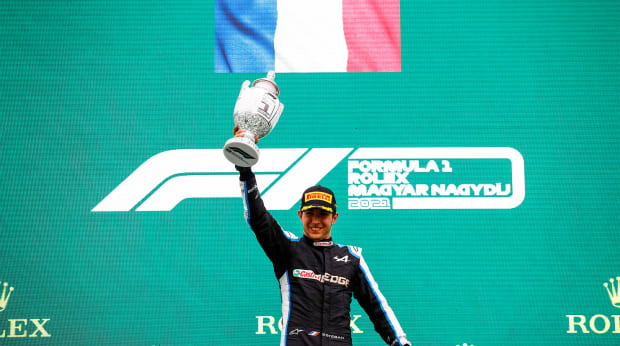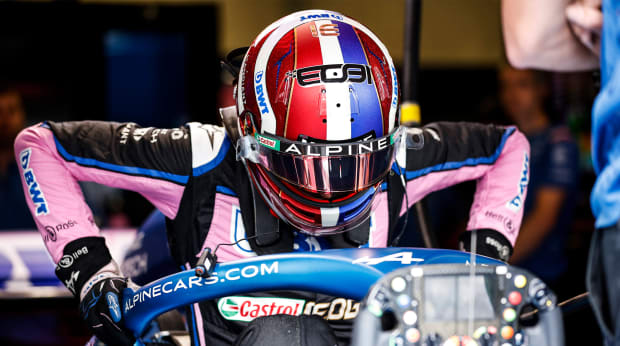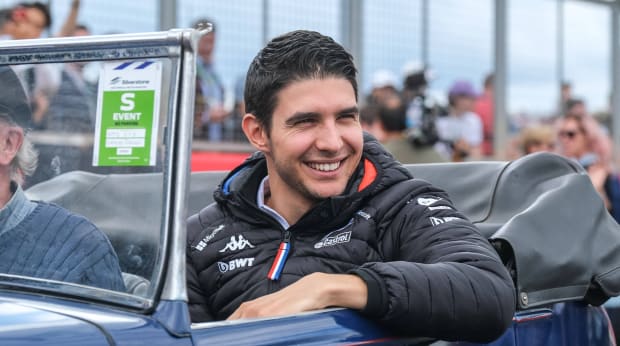The Alpine driver talks about France’s rich motorsport history, coming off his team’s best weekend of the year and what to look for at Circuit Paul Ricard.
France: The home of the Eiffel Tower and macarons, Provence’s lavender fields and two Formula One drivers with Esteban Ocon and Pierre Gasly.
Ocon remembers the day he heard that the French Grand Prix was returning to the calendar. France has an extensive motorsports history, being the first ever to host a race titled as Grand Prix 44 years before the Formula One World Championship was created. Fans have flocked to a French Grand Prix at 16 different circuits throughout its storied history, and it’s been held at Circuit Paul Ricard dating back to 2018 after a decade-long absence from the F1 schedule.
It remains unknown if this will be au revoir to the French Grand Prix as Formula One weighs next season’s schedule. But for Ocon, the future is bright as he finds his footing after 100 F1 starts, turning his dreams into a reality.
Through much sacrifice from his family, the Frenchman broke through in single seaters, even beating eventual world champion Max Verstappen for the European F3 title in 2014. His dominance continued as he grabbed the GP3 title the next campaign, this time being backed by Mercedes.
Ocon eventually found his way into one of the exclusive full-time 20 Formula One seats, beginning his budding career with Force India. The rising star showcased his talent in wheel-to-wheel battles with then-teammate Sergio Perez, but when Lawrence Stroll bought the team halfway through 2018, Ocon was replaced at season’s end as Stroll’s son, Lance, made the jump from Williams.
The Frenchman spent the next year as a Mercedes’s reserve driver, waiting to find an open opportunity to get back on the F1 grid full-time. The time came in 2020 with Renault, which turned into Alpine in ’21, and there was no doubt about Ocon’s talent and determination.
He scored his first podium during the COVID-19 pandemic season and built off of that campaign with his first F1 win in Hungary—one that came out of the blue. The 2021 Hungarian Grand Prix saw a multi-car Turn 1 wreck, Sebastian Vettel’s disqualification after a breach of fuel regulations, Lewis Hamilton taking the world title lead from Verstappen and Ocon grinning ear-to-ear as France’s national anthem echoed in the venue.

IMAGO / PanoramiC
The 2022 campaign has seen Ocon surge in the midfield, sitting just 12 points behind Lando Norris as McLaren and Alpine battle it out each week. The Frenchman has only missed out on points three of the last 11 races, one of which was a DNF in Silverstone.
Ocon is heading into his home Grand Prix coming off an Austrian Grand Prix that saw him pick up a season-high 13 points, but was also emotional. The race marked the Frenchman’s 100th F1 start, a milestone of his dreams that became a reality faster than he expected.
As F1 heads to Le Castellet to brave the heat and the circuit known for overtaking opportunities, Sports Illustrated spoke with Ocon about what makes racing in France so special, what fans should look for at Circuit Paul Ricard and his advice for the next generation.
Fuel for Thought is Sports Illustrated’s exclusive Q&A with Formula One’s biggest names. The following questions and answers have been edited for brevity and clarity.
Sports Illustrated: How is it being home?
Esteban Ocon: It’s fantastic. Thank you very much. I’m extremely excited about the weekend. It’s home race. We are going to have all our supporters here, the race is colored with our race car color. It’s extremely special. It’s a big weekend for me and for the team, and I hope we can put on a good show for our fans.
SI: What makes racing in France so special because there is a deep motorsports history?
EO: In Formula One, you go to all the venues, and it’s called Grand Prix. And Grand Prix is obviously a French word. It’s the meaning of [great] price. We have a huge, huge community for motorsport. We have some of the best sports brands, sportscast brands in the world, and we have some great venues like Paul Ricard the circuit, like Le Mans, which is one of the biggest races in the world as well with the 24 hours. We had some extremely talented French drivers in the past which has contributed to history and that have been mega successful.

IMAGO / HochZwei
SI: 100 Grand Prix starts is a huge accomplishment as there’s only 20 seats in F1. What does that mean to you, and as a young kid dreaming, did you think that you would be able to get to that milestone?
EO: It’s quite emotional, I have to say, to get to 100 Grand Prix. You want to get to Formula One as a kid racing in go-karts. That’s always what I wanted to do. But I never thought it would go that fast. I still feel like I’ve just arrived to Formula One, and I still have a lot to achieve, obviously. But time flies. Time goes by very quickly, and to have done 100 races, it’s pretty special.
SI: Looking back at the Austrian Grand Prix, what stood out to you that didn’t make the headlines?
EO: Racing-wise, it was quite an interesting race, and we had a great race. On our side, I scored 13 points in total, [including] in the sprint race, and for me to achieve that in my 100th race was pretty special to get that result. We were very quick, and we managed to have a car which was very decent and a very good platform. That gives us confidence coming into the French Grand Prix here. It was definitely one of the our best weekends of the year, and to make it the 100th Grand Prix also with me, it’s nice to have that feeling.
SI: Looking ahead to this weekend, what should fans be watching for at the French Grand Prix? What part of the track is the most challenging and why?
EO: So the most challenging part is definitely after the long straight, you have, you have the chicane, and then you have Signe, which is a very flat out corner about 300 kph. And you have a double right, which is flat out as well at around 310. And you’re slowing down in the middle of it. That corner puts five-and-a-half G’s to our body in qualifying. It’s a huge challenge for us as athletes inside the car, physically with the heat as well. But it’s also very important for the engineer to get the car right and to have the confidence to attack such a corner.
SI: With how tight the corners are, I’m guessing track limits are all always kind of a concern, and I know that was a theme at Austria.
EO: Yeah, for sure. Things need to happen in order to make the tracks a little bit harder for us to go out of track limits. But what’s good about this year at least is that it’s the white line everywhere. And if we go above, we know that we are outside of the rules. I don’t think it will be as bad in Paul Ricard compared to Austria. But yeah, for sure. As a driver, it was pretty difficult to stay within the limits there.
SI: There’s been some speculation and rumors about the future of the French Grand Prix. Can you talk about that on your side because having a home race is important to each driver?
EO: To me, it was definitely the best news of the whole year when I heard the Grand Prix was about to come in 2018. I remember hearing the news in 2017, and I was delighted. It was such a long time that the Grand Prix was supposed to happen, and there was rumors and talks about it happening. But I started to lose hope, and the Grand Prix came alive. I managed to race at home now for … [this] would be the third one for me. It’s extremely special, of course. But yeah, I’m hearing the rumors. They are only rumors at the moment that the Grand Prix is not going to take place in the future. But yeah, I’m hearing a lot of different things from the bosses of F1. I saw some statement that they are talking about another venue, potentially in the street circuit in France, and we have a lot of great places. I’m sure that the Grand Prix could take place, and it’s only a matter of making it happen, I guess.

IMAGO / Eibner
SI: A simple but deep question—who is Esteban Ocon?
EO: It’s a good question, not an easy one to answer. Usually I prefer my family or my close friends to really describe me because I think you always have a lot more to learn from what people think about you, especially from the negatives. That’s what I try to learn as well on how to get better in a lot of different aspects. But I would probably define me as a passionate guy in what I do. I live for racing. I train for racing. I sleep for racing. That’s, that’s my whole life. But yeah, I’m determined, motivated and passionate.
SI: Sacrifice is a word we hear a lot within the sports industry, but particularly within F1. What does that word mean for your story?
EO: It means a lot. It’s a big part of my career. I’ve been sacrificing most of my young life with my parents and my family in general. It’s been tough times to get to where we are today, but that’s the past now. We’re enjoying the present and the future coming ahead. The sacrifices meant a lot back then, but it has created a great future.
SI: Speaking of the future, what would your advice be to this next generation? They’re growing up within a digital age with social media.
EO: Social media can be great at times, but can be also dangerous. We should take social media lightly in general and not focus too much on it or spend too much time on it. Life through your own eyes is a great chance to have, and we don’t necessarily need all the time to look at who’s doing what, who’s doing what, where. You have to create your own memories. That’s the main thing that the youngsters should do. If there are some karters out there that can you hear me, just enjoy being able to race. If that’s the case, they are one of the lucky ones. … Don’t take yourself too seriously. Compete if you can and enjoy what you do.
More Formula One Coverage: